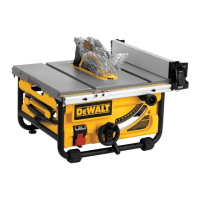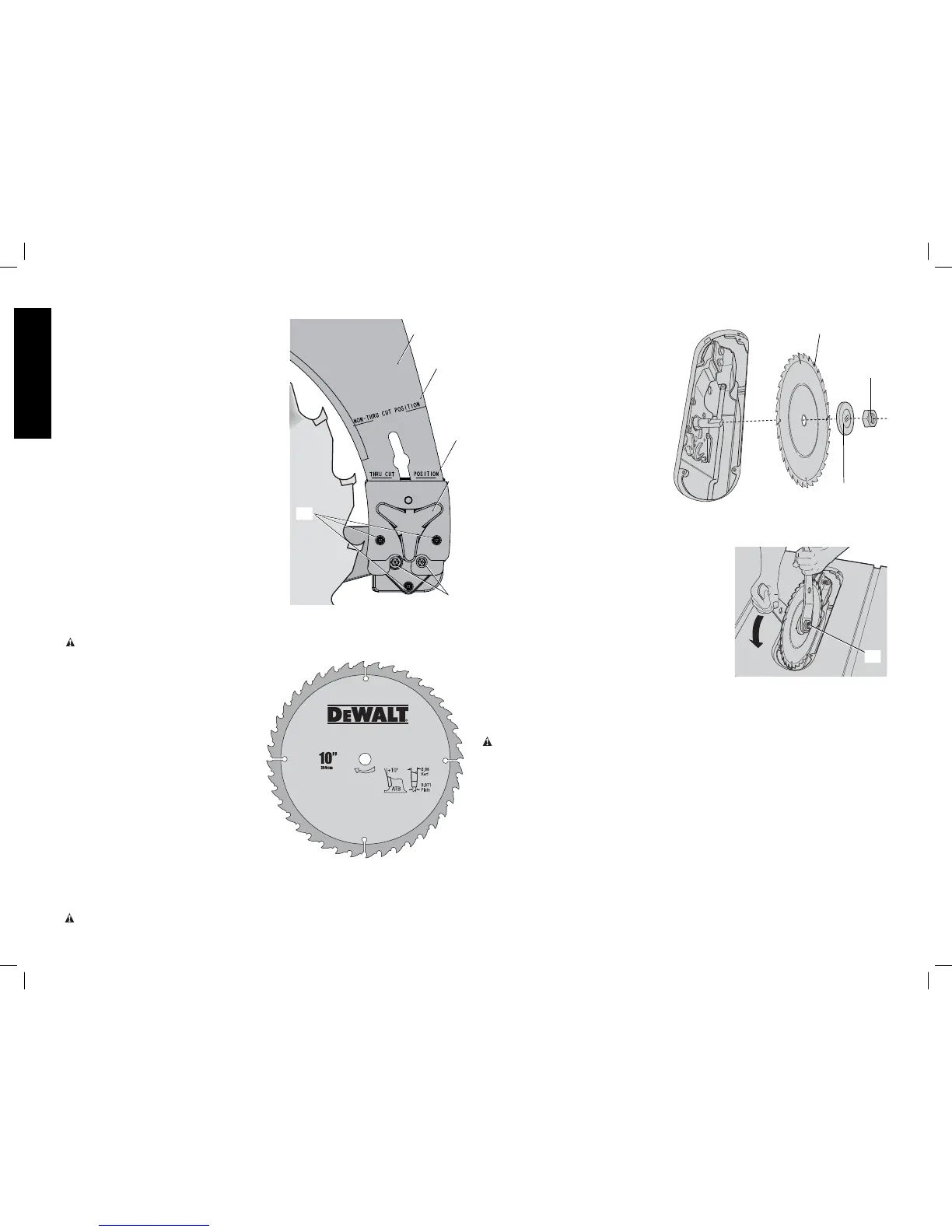10
English
3. If needed, raise the riving knife (FF) to the
FIG. 25
A1
ZZ
A2
A3
YY
FF
thru cut (ZZ) or highest position. Refer to
Positioning the Riving Knife under
Assembly.
4. Locate the three small set screws (A2)
adjacent to the riving knife lock knob (YY).
These screws will be used to adjust the riving
knife position.
5. Lay a straight edge on the table against two
blade tips. The riving knife should not touch
the straight edge. If needed, loosen the two
larger lock screws (A3).
6. Adjust the small set screws (A2) to move the
riving knife according to the position noted in
step 5. Lay the straight edge on the opposite
side of the blade and repeat adjustments as
needed.
7. Lightly tighten the two larger lock screws
(A3).
8. Place a square flat against the riving knife to
the verify riving knife is vertical and in line with
the blade.
9. If needed, use the set screws to bring the
riving knife vertical with the square.
10. Repeat steps 5 and 6 to verify position of
riving knife.
11. Fully tighten the two larger lock screws (A3).
Saw Blades
WARNING: Riving knifes must be matched to saw blade dimensions in order to function
effectively. Refer to Riving Knife Selection.
NOTE: THIS SAW IS INTENDED FOR USE
FIG. 26
ONLY WITH SAW BLADES 10" (254mm) IN
DIAMETER. Refer to Fig. 26.
NOTE: This saw is not intended for use with
dado blades and molding cutters. Personal
injury may occur.
1. The saw blade furnished with your new
saw is a 10" (254 mm) combination
blade, used for crosscutting (across
the grain) and ripping (with the grain)
through the material. The center hole to
fit on the arbor is 5/8" (16 mm) diameter
(.625"). This blade will produce a good
quality cut for most applications.
2. There are many types of blades available
to do specific and special jobs such as
crosscut only, rip only, hollow ground,
thin plywood, paneling, etc.
3. Use only saw blades designed for
maximum safe operating speeds of 5,000 RPM or greater.
4. Saw blades should always be kept sharp. It is recommended that you locate a reputable
sharpening service to sharpen your blades when needed.
CAUTION: Abrasive wheels or blades (including diamond) should not be used on this saw.
Blade (Fig. 3, 6, 27, 28)
REPLACING THE BLADE
1. Raise the saw blade arbor to its
FIG. 27
C
Y
Z
maximum height by turning the blade
height adjustment wheel (I) clockwise.
2. If replacing the blade, remove the
blade guard assembly (D) and throat
plate (X) prior to installing the new
blade. (Refer to To Remove the
Blade Guard Assembly and To
Remove the Throat Plate under
Assembly.)
NOTE: It may be easier to change
the blade with the saw blade
beveled to 0˚.
3. Remove the arbor nut (Y) and outer
washer (Z) and set aside.
4. Place the blade (C) on the arbor making sure the teeth of the blade point downward and
toward the front of the saw.
5. Place the outer washer (Z) against the blade, raised
FIG. 28
Y
side out and tighten the arbor nut against the
washer as far as possible by hand. Ensure that the
outer washer and arbor nut are free of dust and
debris before installing.
6. To further tighten the arbor nut (Y), use the open
ended spindle wrench (supplied) to keep the spindle
from rotating.
7. Use the arbor wrench (supplied) to hold the nut
and tighten it by turning it clockwise. Reposition the
wrench on the arbor nut and repeat as necessary
until the nut and washer are securely fastened
against the blade).
NOTE: Different types of blades make different kerfs (width of cuts). Therefore, it is necessary
to check adjustment of rip scale when changing blades. Replacement blade MUST not exceed
the thickness stated on the riving knife. The riving knife provided with the saw is 2.2mm thick.
Riving Knife Selection
WARNING: To minimize the risk of kickback and to ensure proper cutting, the riving knife
must be the proper thickness for the blade used.
The riving knife supplied with this table saw is the correct size for the blade supplied with the
saw.
If a different blade is used check the blade body (plate) thickness and the blade kerf (cutting)
width marked on the blade or on the blade packaging. The riving knife thickness must be
greater than the body thickness and less than the kerf width as shown in Figure 29. If it is not,
the riving knife MUST be replaced with one that has the correct thickness.
The riving knife provided with this saw is marked as follows (Fig.30):
0.087" (2.2mm) THICK RIVING KNIFE. ONLY USE FOR 10" (254mm) Ø BLADE
WITH 0.094" (2.4 mm) MIN. KERF WIDTH AND 0.067" (1.75 mm) MAX. BODY
THICKNESS.
The riving knife available as an accessory marketed by D
EWALT is marked as follows:
0.110" (2.8 mm) THICK RIVING KNIFE. ONLY USE FOR 10" (254mm) Ø BLADE
WITH 0.118" (3.0 mm) MIN. KERF WIDTH AND 0.098" (2.5 mm) MAX. BODY
THICKNESS

